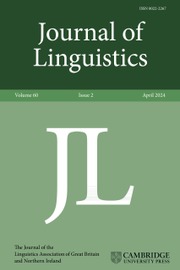Constraints on multiple center-embedding of clauses
Published online by Cambridge University Press: 18 June 2007
Abstract
A common view in theoretical syntax and computational linguistics holds that there are no grammatical restrictions on multiple center-embedding of clauses. Syntax would thus be characterized by unbounded recursion. An analysis of 119 genuine multiple clausal center-embeddings from seven ‘Standard Average European’ languages (English, Finnish, French, German, Latin, Swedish, Danish) uncovers usage-based regularities, constraints, that run counter to these and several other widely held views, such as that any type of multiple self-embedding (of the same clause type) would be possible, or that self-embedding would be more complex than multiple center-embedding of different clause types. The maximal degree of center-embedding in written language is three. In spoken language, multiple center-embedding is practically absent. Typical center-embeddings of any degree involve relative clauses specifying the referent of the subject NP of the superordinate clause. Only postmodifying clauses, especially relative clauses and that-clauses acting as noun complements, allow central self-embedding. Double relativization of objects (The rat the cat the dog chased killed ate the malt) does not occur. These corpus-based ‘soft constraints’ suggest that full-blown recursion creating multiple clausal center-embedding is not a central design feature of language in use. Multiple center-embedding emerged with the advent of written language, with Aristotle, Cicero, and Livy in the Greek and Latin stylistic tradition of ‘periodic’ sentence composition.
Information
- Type
- Research Article
- Information
- Copyright
- 2007 Cambridge University Press
Footnotes
- 76
- Cited by

